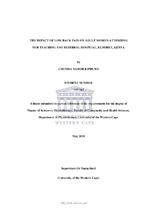| dc.description.abstract | Low back pain is one of the most frequent health problems and also one of the most prevalent musculoskeletal disorders. It’s the leading reason for activity limitation and job absenteeism which leads to huge economic burden on persons, society, industry and governments. Women are more susceptible to low back pain due to hormonal effects, differences in reporting of somatic symptoms and greater sensitization of pain. The aim of this study was to determine the impact of low back pain on activities of daily living and quality of life of adult women attending Moi Teaching and Referral Hospital (MTRH), Eldoret, Kenya. The following objectives were addressed, namely to determine pain intensity, functional disability and quality of life of adult women as well as to explore the activities of daily living that may contribute to low back pain. A sequential explanatory mixed method approach, comprising of a cross-sectional descriptive and explorative design for the quantitative and qualitative phases respectively, was employed in the study. A self-administered questionnaire consisting of four sections (socio-demographic information, the Nordic Musculoskeletal Questionnaire, the Oswestry Disability Index Questionnaire and World Health Organization Quality of Life Tool) was completed by two hundred and thirty-four adult women with a mean age of 38.54 years (SD=9.40). Twenty-six women participated in the focus group discussions. Results of the study indicate that 94.6% of the women had experienced low back pain in the past year while 90.1% had low back pain in the past seven days. In addition, more than half of the women (52.3%) experienced moderate pain intensity. Almost three quarters (68.1%) of the participants who experienced pain in the past year reported that low back pain prevented them from carrying out their activities of daily living. Half of the participants (50.2%) had moderate disability. A significant positive correlation was found between pain and disability (r = 0.426; p = 0.000) while a non-significant negative correlation was found between low back pain and quality of life (r = -0.058; p = 0.390). The qualitative results showed that women have difficulty in performing certain activities of daily living i.e. personal hygiene, sitting, standing and housework due to low back pain. A significant correlation was found between pain intensity, disability and quality of life. Such correlations advocate towards the bio-psychosocial model in management of low back pain. There is a need to invest in primary-based health care to include low back pain and its related risk factors, in order to advise the affected population on appropriate and essential prevention strategies. Future interventions should focus on enhancing physical health and psychosocial stress in women with low back pain. | en_US |

